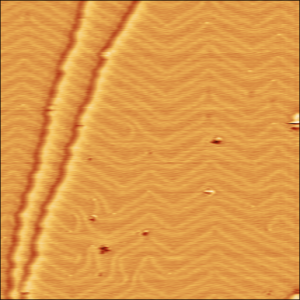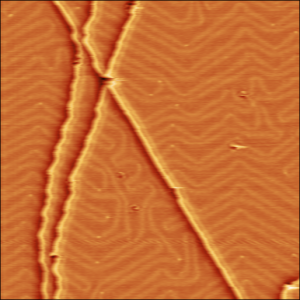Permanent people : J. Colin (PR), C. Coupeau (PR), J. Grilhé (Emerit), J. Durinck (MdC), A. Cimetière (Emerit), L. Vernisse (MdC)
PhD Students: Romain Gautier (2028-2021), Emmanuel Fodeke (2019 - 2022), Charlélie Chil (2020-2023), V. Khoroshilov (2021-2024)
Post-doctoral fellows: Simon Smalley (2020 ->)
Context and objectives :
We are focusing our researchs on the evolution of surfaces under mechanical strains. Our objective is to understand the phenomena linked to the thin films buckling, delamination, decohesion or to surface reconstruction. Bearing this mind, we developped an unique experimental apparatus called Nanoplast. It combines an AFM/STM head and a compression system under UHV to follow in situ the evolution of material surfaces under stress/strain and variable temperatures. Thoses experiments are closely associated to numerical simulations or models.
Our current studies can be divided into two main themes:
-
- to understand of the fundamental plasticity mechanisms of crystallin materials from the investigation at the atomic scale of slip traces emerging at the surface
- to control nanostructures and surface reconstruction through mechanical nano-engineering under strain
-
-
Surface nano-engineering
-
Surface reconstruction offers the opportunity to give materials new properties through their surface. The objective is to drive the surface reconstructions or the formation of nanostructures and use them as templates to functionnalise the surface.
We are interested in three types of surfaces :
-
- Surfaces with existing recontructions, as Au(111): we are investigating the response of the herringbone reconstruction to a stress or to the emergence of slip traces created beyond the elastic limit. In other words, we are investigating the influence of the stress fiels generated by the surface atomic steps and the possible interaction between herringbone and slip traces
- 2D materials, as transition metal dicalchogenides (ex: MoS2) on metallic monocrystals: we are investigating the mechanical properties of those ultrathin films and try to control their functionnal properties under a local strain/stress
- Supramolecular autoassemblies on metallic substrates: the objective is the creation of organic nanostructures which can be patterned by controling the evaporation conditions, by intercalating metallic clusters or by stressing the substrate

STM image of the Au(111) herringbone reconstruction
before uniaxial deformation

STM image of the herringbone reconstruction
after emergence of a slip trace induced by uniaxial deformation
-
-
Morphological evolution of stressed alloys
-

This theme of traditional metallurgy concerns the study of the morphological evolution of alloys, when they are subjected to stresses. Our goal is to determine the critical parameters responsible for the change of shape of these materials when diffusion phenomena are activated.
The first part of this theme focuses on the linear study of the growth by diffusion of cylindrical or spherical precipitates under stress in contact with their liquid phase. The shape instability thresholds could thus be characterized for binary or ternary alloys (in collaboration with P. Voorhees Northwestern University, USA).
The second part focuses on the effect of a free surface on the morphology of a precipitate constrained in a semi-infinite matrix. A first calculation of static energy showed that the precipitate placed in the vicinity of the free surface could extend in the direction perpendicular to this surface. In order to confirm this evolution, a collaboration with F. Montalenti and R. Bergamaschini of the Bicocca University of Milan was initiated and made it possible to carry out phase-field simulations of the evolution of precipitates in the vicinity of a free surface when diffusion at the precipitate / matrix interfaces is activated. These simulations have indeed demonstrated a displacement as well as an elongation of the precipitates in the direction perpendicular to the surface. These numerical results could be compared with observations made by B. Rosen of Tel Aviv University on Ni particles migrating in a LaO3 matrix.
-
-
Effect of plasticity on thin film buckling
-
This research activity has a multi-scale approaches of the buckling of thin films on substrates. It aims to study the influence of plasticity mechanisms on the delamination and buckling of thin crystalline films deposited on substrates. In order to carry out this activity, atomic-scale simulations by molecular dynamics as well as mesoscopic-scale finite element simulations are carried out. These numerical simulations are supplemented, when possible, by an analytical treatment of buckling within the framework of the elastic theory of thin plates in collaboration with G. Parry (SIMAP, Grenoble).
Recently, free air optical observations of ductile gold films deposited on silicon substrates have shown different buckling structures. In order of increasing size, circular blisters, crescent-shaped blisters and finally donut-shaped blisters have been experimentally characterized. In this context, weused finite element simulations to set out the coupled effects of overpressure and film plasticity on the morphology of flamed structures. In agreement with the observations, we assumed that a plastic fold develops on the perimeter of the circular blisters. The application of an overpressure of the order of atmospheric pressure on the surface of the film therefore led us to the generation of the different structures observed experimentally at different sizes. These simulations allowed us to conclude that the plastic folding / pressure coupling could explain the varied morphologies observed at the different sizes of delaminated zones on the surface of gold films. Still using finite elements, a dynamic study of the propagation of straight wrinkles in the presence of an interface step between a film and its substrate was then carried out using a code developed by G. Parry. Thus, we highlighted an effect of deviation of the wrinkle by walking.
We are also interested in the elementary plasticity mechanisms activated in aluminum films subjected to increasing deformation. In 0 K molecular dynamics simulations, it has been shown that the interface energy drives the plasticity of the film during buckling. Different phenomena have been identified as a function of this adhesion energy: emission of interface dislocations and delamination, formation of cracks in the film from interface cracks or formation of twins. In a second step, we studied by molecular dynamics at finite temperature, the plasticity mechanisms activated during the buckling of an Al film when an S (51) (551) grain boundary is placed in this film. We showed that the plasticity initiated at this joint strongly modifies the profile of the wrinkle. Two mechanisms have been identified, the formation of extrinsic faults in the upper part of the film in tension and intrinsic faults in the lower part in compression. Following the activation of these microscopic mechanisms involving perfect dislocations and Schockley partial dislocations, we identified two mesoscopic parameter, a plastic deformation and a bending angle. There integration into a description of the buckling in the frame of the theory of thin plates allowed us to reproduce the profiles of the films after buckling obtained in the simulations.
-
-
Nanostructure plasticity
-
This activity concerns the theoretical study of the mechanical stability of nanostructures of different geometries with respect to the introduction of dislocations, when stresses are present in these composite structures. Several problems have thus been addressed such as the introduction of a wedge dislocation dipole in semi-epitaxial flat layers buried in a matrix or the formation of prismatic dislocation loops in cylindrical or spherical core / shell structures. The final objective of these studies is to propose stability diagrams with respect to the formation of these defects as a function of parameters such as the stresses and the geometric characteristics of the layers. In the same vein, the fracturing of cylindrical materials subjected to axial stress was studied and the distribution of cracks was characterized. More recently, attention has focused on the effects of disclinations placed in grain boundaries of strong disorientation and sources of significant deformations, on the formation of dislocations from free surfaces. The conditions of these nucleations were specified as a function of the disorientation associated with these disclinations and their position relative to the free surfaces of the materials considered.
-
-
Buckling of hyperelastic materials
-
This thematic concerns the folding problems of buried layers and multilayers composed of Neo-Hookean materials in the framework of a collaboration with M. Holland and M. Darayi, of the University of Notre Dame, USA. These composite materials, which can undergo large deformations with significant heterogeneities of elastic moduli, are the subject of numerous studies in biology (morphogenicity and growth of tissues, development of tumors, etc.) or in electronics (deformable devices on the skin).
In this context, we were able to characterize in the linear regime the instability thresholds of folding under external deformation of a layer buried in a matrix, then of two layers in elastic interaction in a matrix. The effects of the elastic moduli of different materials, layer thicknesses and the distance between layers were thus characterized on the folding modes (symmetrical, antisymmetric), on the wavelengths and the corresponding critical deformations. It appears through these studies that for the layers harder than their matrix, the symmetrical folding mode is selected.
Selection of recent papers:
2022
Colin, J.
Effect of stiffness contrast on the dislocation equilibrium positions in a multi-layered structure
International Journal of Solids and Structures , 234-235, pp. 111244, 2022.
2021
Rochefort, A.; Vernisse, L.; Gómez-Herrero, A.C.; Sánchez-Sánchez, C.; Martín-Gago J.A.; Chérioux, F.; Clair, S.; Coraux, J; Martínez J.I.
Role of the Structure and Reactivity of Cu and Ag Surfaces in the Formation of a 2D Metal–Hexahydroxytriphenylene Network
The Journal of Physical Chemistry C , 125 (31), pp. 17333-17341, 2021.
Chauraud, D.; Durinck, J. ; Vernisse, L. ; Smalley, S. ; Drouet, M. ; Coupeau, C.
External stress as a way to control Au (111) reconstruction
Surface Science , 714, pp. 121908, 2021.
Colin, J.
Formation of Two Edge Dislocations in a Grain Due to Interface Disclination Dipoles
Journal of Applied Mechanics , 88(9), pp. 091007, 2021.
Bertin, B.; Durinck, J.; Grihlé, J.; Colin, J.
Grain boundary-induced plasticity during thin film buckling
Surface and Coatings Technology , 408, pp. 126817, 2021.
Abbes, F.-Z.; Coupeau, C.; Durinck, J.; Talea, M.; Ni, Y.; Parry, G.
Effect of substrate elasticity on thin film buckle morphologies: A phase diagram
Surface and Coatings Technology , 408, pp. 126817, 2021.
2020
Douat, B.; Bonneville, J.; Douet, M.; Vernisse, L.; Coupeau, C.
Low temperature atomic-scale observations of slip traces in niobium
SCRIPTA MATERIALIA, 183, pp. 81-85, 2020.
Coupeau, C.; Michel, J. ; Bonneville, J. ; Drouet, M.
An atomic-scale insight into Ni3Al slip traces
MATERIALIA, 9, pp. 100563, 2020.
2019
Chauraud, D.; Durinck, J. ; Drouet, M. ; Vernisse, L. ; Bonneville, J. ; Coupeau, C.
How slip traces modify the Au(111) reconstruction
PHYSICAL REVIEW B, 99(19) pp. 195404, 2019.
Parry, Guillaume ; Hamade, Sami; Durinck, Julien; Coupeau, Christophe; Colin, Jérôme
Influence of interface steps on the buckle delamination of thin films
JOURNAL OF THE MECHANICS AND PHYSICS OF SOLIDS, 132, pp. 103698, 2019.
Coupeau, D.M. Kazantsev, M. Drouet, V.L. Alperovich,
Kinetics of anticrossing between slip traces and vicinal steps on crystal surfaces
ACTA MATERIALIA, 175, pp. 206-213, 2019.
Coupeau, R. Boijoux, Y. Ni, G. Parry,
Interacting straight-sided buckles: An enhanced attraction by substrate elasticity
Journal of the Mechanics and Physics of Solids 124, pp. 526, 2019.
B. Douat, C. Coupeau, J. Bonneville, M. Drouet, L. Vernisse, L. Kubin,
Atomic-scale insight into non-crystallographic slip traces in body-centred cubic crystals
SCRIPTA MATERIALIA, 162, pp. 292, 2019.
2018
Colin, Jérôme
Equilibrium Shapes of Coherent Precipitates Near a surface
MECHANICS OF MATERIALS, 117, pp. 22-31, 2018
2017
Abbes, Fatima; Durinck, Julien; Talea, Mohamed; Grilhé, Jean; Colin, Jérôme
Cuboidal-to-pyramidal shape transition of a strained island on a substrate
SURFACE SCIENCE, 664, pp. 168-171, 2017
2016
Ruffini, Antoine; Finel, Alfonse; Colin, Jérôme; Durinck, Julien
Effect of interface plasticity on circular blisters
SCRIPTA MATERIALIA, 113, pp. 222-225 , 2016
2015
Hamade, Sami; Durinck, Julien; Parry, Guillaume; Coupeau, Christophe; Cimetière, Alain; Grilhé Jean; Colin, Jérôme
Effect of plasticity and atmospheric pressure on the formation of donut- and croissant-like buckles
PHYSICAL REVIEW E, 91, pp. 012410-n.c, 2015
